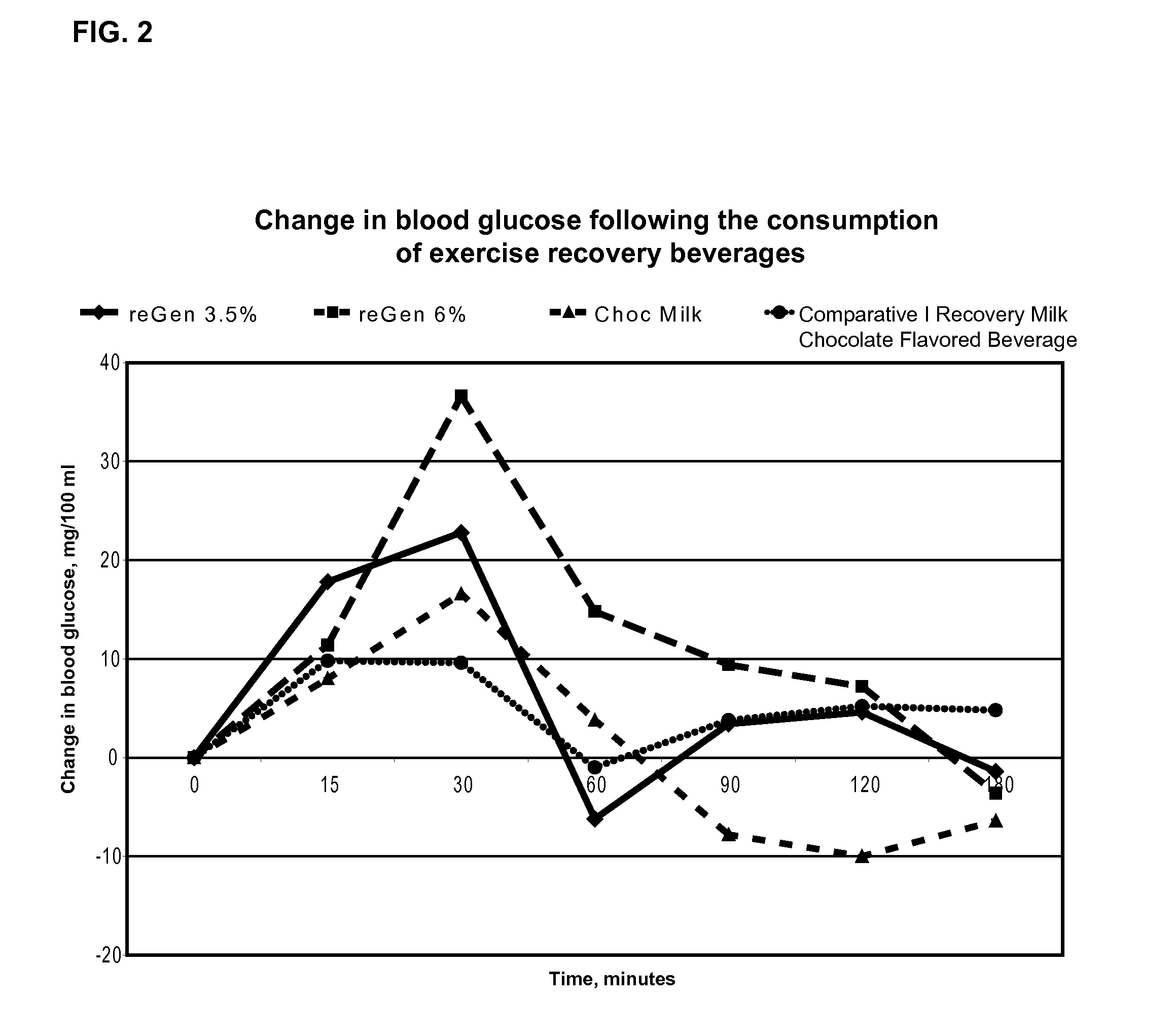[0006]The present invention relates to beverages with high levels of cocoa flavanols from cocoa solids, or more specifically a cocoa
powder, and the use of these beverages in
exercise recovery regimens. Exercise routines and cocoa beverage administration regimens are designed to measure
biochemical markers in each of two intense workouts separated by a
rest period, approximately four hour rest between exercises. The exercise routines are designed to test subjects to exhaustion and blood samples are taken before and after. Levels of
Creatine Phosphokinase (CPK),
Lactate Dehydrogenase (LDH),
plasma nitrates and
Nitric Oxide metabolites (
NOx) can then be correlated with
physical performance and the type of
recovery beverage used, and the amount of cocoa powder, or cocoa solids or cocoa flavanols, present in the beverage. As shown below, beverages with higher levels of cocoa solids or cocoa flavanols enhance
muscle recovery after intense exercise.
[0008]High levels of cocoa are a source of
starch and when heated at 170°-180° F. can solidify and become viscous at those temperatures. In the inventive process, aseptic homogenization, or ultra-high temperature conditions followed by homogenization, results in advantageous characteristics in beverages such as a reduction in
viscosity and improved
mouthfeel. Accordingly, the beverages of the invention, in particular, can be produced from the inventive methods to reduce the overall
viscosity of the final product.
[0011]In particular, beverages with cocoa powder levels (or the equivalent in cocoa solids) of about 3.5% or about 6% can be used, especially in combination with a
carbohydrate to protein ratio of about 3:1, or from about 2.5:1 to about 4:1 or any ratio in between. Contrary to other products with high levels of cocoa solids, the beverages of the invention can be made so that they do not display a bitter or
astringent taste characteristic. Furthermore, the beverages have an acceptable
mouthfeel, maintain a stable solution with substantially no bottom residue or separation after storage for up to 6 or 12 or more months, and are stable to
room temperature and cooled storage conditions.
[0014]The levels of natural cocoa powder or natural cocoa products present as compared to the levels of other cocoa products can be presented by a percentage of natural cocoa products to total cocoa products, so that, for example, between 80-90% of the total cocoa products present are natural cocoa products. Preferably, the combination of
cocoa powders or products yields a stable, shelf stable, and / or extended
shelf life product with
antioxidant levels of about 10,000 umol TE per 8 oz serving (Trolox Equivalent in an
Oxygen Radical
Absorbance Capacity ORAC
assay), or about 575 mg total polyphenols per 8 oz serving, or about 345 mg
polyphenol monomers per 8 oz serving, or about 547 mg GAE per 8 oz serving (
gallic acid equivalent). In particular, an 8 oz. serving can have more than 200 mg of total polyphenols (TP), or more than 500 mg TP, or more than 1,000 mg TP, or more than 1,500 mg TP. In other preferred embodiments of an 11 oz.
serving size, the levels of particular cocoa flavanol compounds and total cocoa flavanols are:CatechinsEpicatechinsProcyanidinsTotal CocoaFormula(mg)(mg)(mg)Flavanols (mg)3.5% Natural14.721.7122.5158.9Cocoa6.0% Natural2849262.5339.5Cocoa5.0% Nat +24.838.5206.5269.81.0% AlkComparative I0.34<0.001<0.001<1
Recovery MilkChoc FlavoredBeverageComparative II<0.001<0.001<0.001<1
Recovery ChocFlavoredBeverageComparative0.511.022.544.07Choc MilkIn the various comparative
exercise recovery and chocolate milk beverages containing cocoa listed in the above table, the cocoa used must be alkalized cocoa or the levels of cocoa very low in order to have the low levels of beneficial cocoa flavanol antioxidants. The 3.5% and 6% compositions from above are water-based aqueous compositions of the invention, with high levels of natural cocoa powder (3.5% and 6% by weight). The 5% natural cocoa+1% alkalized cocoa sample of the invention is a dairy-based aqueous composition. In the table above, the total cocoa flavanols represents the catechins+epicatechins+procyanidin polymers (up to 10-mers) measured from each formula. One of skill in the art is familiar with numerous and similar measurements for
antioxidant capacity and flavanol and
antioxidant quantification, and any method available can be used. In addition, the combination of natural cocoa powder and alkalized cocoa powder, and other
cocoa powders, cocoa products or extracts, can provide a broad taste and bitterness profile and can be used to improve taste, bitterness, and color in a final product.
[0018]In particularly preferred embodiments, the invention comprises beverages that contain efficacious cocoa polyphenols and / or cocoa antioxidants. Along with the exercise
recovery uses and methods described here, these beverages can be used in a
healthy diet, for example a diet to improve cardiovascular conditions or prevent cardiovascular
disease, high
blood pressure, atherosclerosis,
arteriosclerosis, or other diseases. Another aspect of the invention is to provide a cocoa beverage composition that is a
lactose-free, no
sugar added,
sugar-free,
low calorie, and / or substantially
calorie-free cocoa beverage. Yet another aspect of the invention is to provide a cocoa beverage that is no
sugar added, sugar-free,
low calorie, and / or
calorie-free or substantially
calorie-free product and which optionally contains other available or known supplements, active ingredients,
appetite suppressing agents, and similar agents or ingredients, especially those also found in antioxidant-containing
plant products and foods, such as, but not limited to, herbs, teas, coffees, and berries. Further, the beverage compositions may be combined with one or more other
dietary nutrients, such as vitamins, minerals, amino acids, sterols, plants sterols,
omega-3 fatty acids, etc., to provide a nutritional or
dietary supplement. Any of these combinations of the invention can advantageously provide benefits to
human health and capture additional beneficial effects. All of the ingredients or combinations may be combined with appropriate stabilizers, preservatives, binders, emulsifiers, weighting agents, and other edible or ingestible compounds known to one of skill in the art in the industry to produce a beverage.
 Login to View More
Login to View More  Login to View More
Login to View More 


